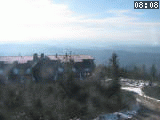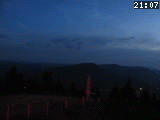Lysá hora 1323 m n. m. - královna Moravskoslezských Beskyd
Saturday 24. May 2025
Tábor and its surrounding [ Region ]
Tábor and its surrounding
It is a region with unusual natural beauty. Hilly, mostly forested northern part of region with plenty of ponds is a heaven for walking tourists, fishers and for lovers of winter sports. The axe of the region is the river Luznice, witch is retaining its original character and witch is one of the mostly visited rivers in Bohemia. Unique and strange is the marshland countryside on the south of the county with its typical moorland and architecture of the south-bohemian folk baroque. For tourist are attractive the remains of the medieval castles Borotín, Choustnik, Selmberk, Pribenice, Pribenicky and Dobronice.
Tabor - the written history of Tabor's fortified settlement begins already in 13th century, when on the plateau above the river Luznice was settled the town Hradiste. On its ruins was later built a Hussite fortress. Up to this time is still noticeable its layout in the historical part of the town. It was saved even the part of the fortification and cylindrical tower named Kotnov. To the mostly visited place of interests belongs the late gothic building of town hall with the Hussite museum and with the entrance to the accessible underground of Tabor. In the historical Bechyn? gate is placed the exposition "The live and work in the medieval society". It is worth visiting the Saint Philippe and Jacob Church, dean Church of the Tansfiguration and famous fair place Klokoty. To the Tabor belongs probably the oldest artificial water reservoir in the Central Europe- Jordan. Collection of tree species, succulents and cultural plants is possible to admire in Botany garden, the technical place of interest is the railway-track from Tabor to Bechyne, built in 1902-03.
Sezimovo Usti - the original settlement Usti is firstly mentioned in 1262. The town and its surrounding belong to the attractive tourist objects. The Hussite period reminds the ruins of the small castle named Kozi Hradek. The town used to be the residence of the second Czechoslovak president - Dr. Edward Benes, who is buried there.
Veseli nad Luznici - rivers, streams, artificial lakes and marshland - that is the most south part of the region. Remarkable natural beauty and fortune of cultural places of interest belong to inviting opportunities of the town and its surrounding. In the Northwest outbranches the Veselská (Borkovická) marshland, nearby Vlkov you can find Nature Park "South Bohemian sandy desert” with dunes. Water sports and fishing are offered by pellucid water of afloated sandpits of that place. Remarkable dominant of the town is the early gothic Church of "Povyseni sv. Krize” (Elevation of Saint Crucifix), renaissance town hall and next door Weises house ornated with graffiti, where is placed the exhibition of Hussite museum.
Sobeslav - the first historical reference about that nice town on the river Luznice is of the year 1239. The town is historical bound with the house of Rozmberk. From that time preserves part of the town fortification and the torso of the castle with rotund Hlaska. The architectural jewellery of the south bohemian gothic is the Church of Saint Vitus and Minster of Saint Peter and Paul. In the surrounding of the town glitter levels of numerous artificial lakes and to the south-west ranges marshland with widespread mosses. In surrounding villages there are number of buildings in typical style of rural baroque.
Bechyne - balneal town in colourful woody countryside on the junction of the rivers Luznice and Smutna, with tradition of ceramic production. References about spa tradition are old more than 400 years. To the unique places of interest belongs the Franciscan cloister, on which place is today the Church of Rapture of Holy Virgin with unusual cavernous vault. To notable technical relic belongs chained bridge over the Luznice nearby the village Stadlce. Not far from there you can find the ruin of the gothic castle Dobronice.
Mlada Vozice - the oldest reference about Mlada Vozice are of the year 1318. To the notable relic belongs the ruin of the castle Slemberk, which preserved tower is today used as outlook-tower. Another piquancy is a bell-tower of 14th century in the middle of the town, originally used as a watchtower. About the history and concurrence of the town you can get more information in the Memorial of Mlada Vozice and its surroundings.
Jistebnice -commune is mentioned as a market thorp already in the year 1262. It is situated in intact countryside. Among the historical places of interest belongs especially the gothic tower of the St. Michael's Church and Memorial chamber of local patriot - artist Richarda Laudy. Pictorial, hilly countryside attracts especially lovers of hiking and fans of water sports and fishing. Satisfied will be friends of winter sports thanks to pistes (with lifts) called Ounuz, Smrkov and Hurka.
Chynov - the town is one of the oldest constantly settled places in the region - its history is dated since 981. Nearby the town you can find Chynovska cave, which is one of the oldest accessible caves in Europe. To the notable places of interest belongs the Church of Holy Trinity founded in 955. In the local graveyard there are number of secession statues and gravestones made by Frantisek Bilek, Antonin Bilek and Karel Gabriel.
Plana nad Luznici - first written references are of the years 1288-89. To the most significant places of interest belongs the originally gothic St. Wenceslas Church and adjoin parsonage. The commune and its neighbourhood are sought after destination for tourists because of its intact nature in surroundings of the picturesque river Luznice.
It is a region with unusual natural beauty. Hilly, mostly forested northern part of region with plenty of ponds is a heaven for walking tourists, fishers and for lovers of winter sports. The axe of the region is the river Luznice, witch is retaining its original character and witch is one of the mostly visited rivers in Bohemia. Unique and strange is the marshland countryside on the south of the county with its typical moorland and architecture of the south-bohemian folk baroque. For tourist are attractive the remains of the medieval castles Borotín, Choustnik, Selmberk, Pribenice, Pribenicky and Dobronice.
Tabor - the written history of Tabor's fortified settlement begins already in 13th century, when on the plateau above the river Luznice was settled the town Hradiste. On its ruins was later built a Hussite fortress. Up to this time is still noticeable its layout in the historical part of the town. It was saved even the part of the fortification and cylindrical tower named Kotnov. To the mostly visited place of interests belongs the late gothic building of town hall with the Hussite museum and with the entrance to the accessible underground of Tabor. In the historical Bechyn? gate is placed the exposition "The live and work in the medieval society". It is worth visiting the Saint Philippe and Jacob Church, dean Church of the Tansfiguration and famous fair place Klokoty. To the Tabor belongs probably the oldest artificial water reservoir in the Central Europe- Jordan. Collection of tree species, succulents and cultural plants is possible to admire in Botany garden, the technical place of interest is the railway-track from Tabor to Bechyne, built in 1902-03.
Sezimovo Usti - the original settlement Usti is firstly mentioned in 1262. The town and its surrounding belong to the attractive tourist objects. The Hussite period reminds the ruins of the small castle named Kozi Hradek. The town used to be the residence of the second Czechoslovak president - Dr. Edward Benes, who is buried there.
Veseli nad Luznici - rivers, streams, artificial lakes and marshland - that is the most south part of the region. Remarkable natural beauty and fortune of cultural places of interest belong to inviting opportunities of the town and its surrounding. In the Northwest outbranches the Veselská (Borkovická) marshland, nearby Vlkov you can find Nature Park "South Bohemian sandy desert” with dunes. Water sports and fishing are offered by pellucid water of afloated sandpits of that place. Remarkable dominant of the town is the early gothic Church of "Povyseni sv. Krize” (Elevation of Saint Crucifix), renaissance town hall and next door Weises house ornated with graffiti, where is placed the exhibition of Hussite museum.
Sobeslav - the first historical reference about that nice town on the river Luznice is of the year 1239. The town is historical bound with the house of Rozmberk. From that time preserves part of the town fortification and the torso of the castle with rotund Hlaska. The architectural jewellery of the south bohemian gothic is the Church of Saint Vitus and Minster of Saint Peter and Paul. In the surrounding of the town glitter levels of numerous artificial lakes and to the south-west ranges marshland with widespread mosses. In surrounding villages there are number of buildings in typical style of rural baroque.
Bechyne - balneal town in colourful woody countryside on the junction of the rivers Luznice and Smutna, with tradition of ceramic production. References about spa tradition are old more than 400 years. To the unique places of interest belongs the Franciscan cloister, on which place is today the Church of Rapture of Holy Virgin with unusual cavernous vault. To notable technical relic belongs chained bridge over the Luznice nearby the village Stadlce. Not far from there you can find the ruin of the gothic castle Dobronice.
Mlada Vozice - the oldest reference about Mlada Vozice are of the year 1318. To the notable relic belongs the ruin of the castle Slemberk, which preserved tower is today used as outlook-tower. Another piquancy is a bell-tower of 14th century in the middle of the town, originally used as a watchtower. About the history and concurrence of the town you can get more information in the Memorial of Mlada Vozice and its surroundings.
Jistebnice -commune is mentioned as a market thorp already in the year 1262. It is situated in intact countryside. Among the historical places of interest belongs especially the gothic tower of the St. Michael's Church and Memorial chamber of local patriot - artist Richarda Laudy. Pictorial, hilly countryside attracts especially lovers of hiking and fans of water sports and fishing. Satisfied will be friends of winter sports thanks to pistes (with lifts) called Ounuz, Smrkov and Hurka.
Chynov - the town is one of the oldest constantly settled places in the region - its history is dated since 981. Nearby the town you can find Chynovska cave, which is one of the oldest accessible caves in Europe. To the notable places of interest belongs the Church of Holy Trinity founded in 955. In the local graveyard there are number of secession statues and gravestones made by Frantisek Bilek, Antonin Bilek and Karel Gabriel.
Plana nad Luznici - first written references are of the years 1288-89. To the most significant places of interest belongs the originally gothic St. Wenceslas Church and adjoin parsonage. The commune and its neighbourhood are sought after destination for tourists because of its intact nature in surroundings of the picturesque river Luznice.
LOCATION
- Village or Town/City: Tábor
- District of Administration 2: Tábor
- District of Administration 3: Tábor
- Region NUTS 4: Okres Tábor
- Region NUTS 3: Jihočeský kraj
- Region NUTS 2: Jihozápad
- Tourist region: 05 Jižní Čechy
- Destination: Jižní Čechy
INFORMATION: http://www.Czech.Tourism.cz
Type: Region
LAST MODIFY: Ladislav Hollý (archívní záznam) org. 2, 24.10.2004 v 19:08 hodin



